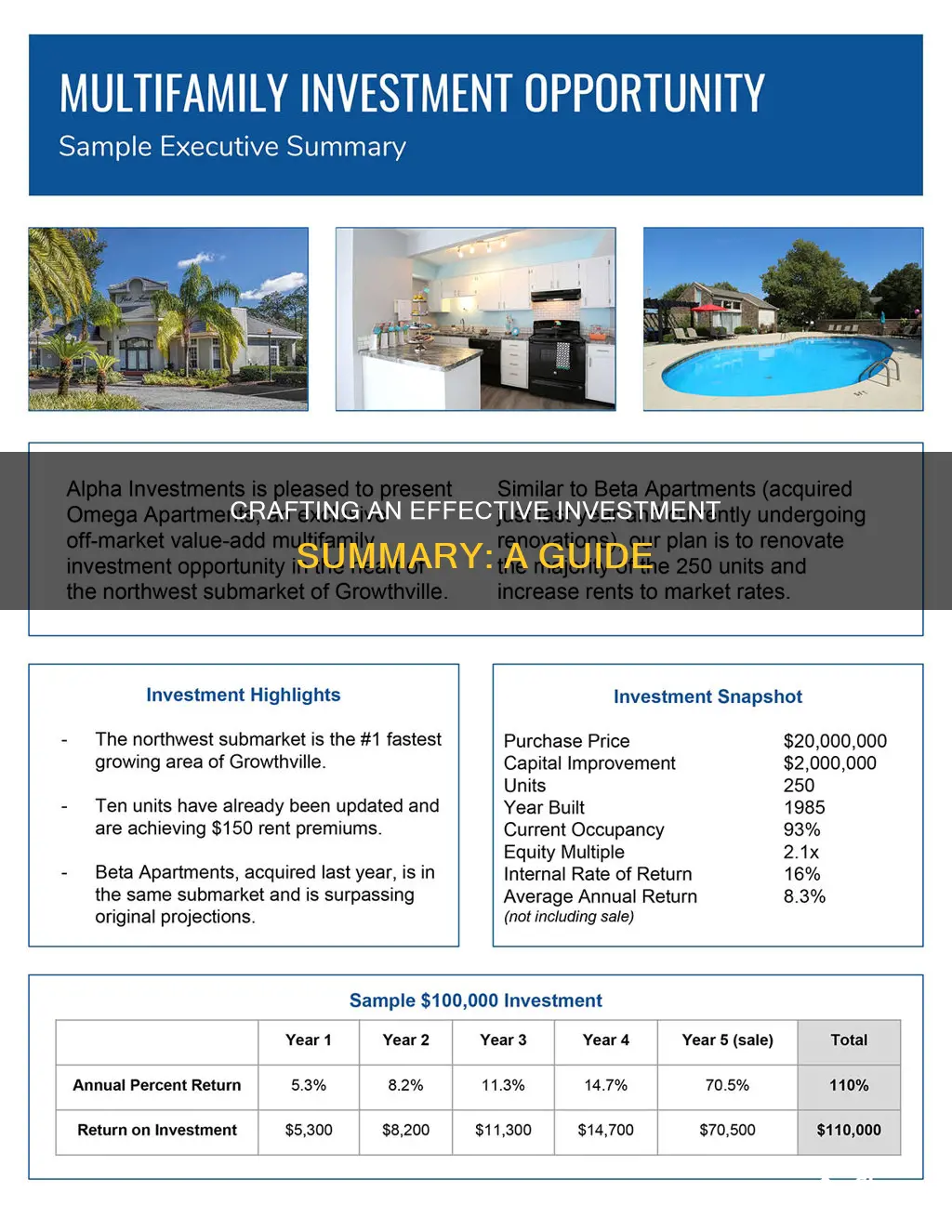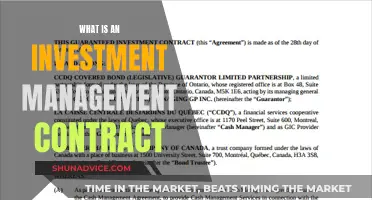
An investment summary is a crucial document for any business seeking funding. It is a detailed plan that outlines a business idea and how it can be transformed into a venture worth investing in. The summary needs to be concise yet informative, providing investors with an overview of the project or company, including its objectives, strategies, and financial projections. Creating an effective investment summary can be challenging, but it is a vital tool for attracting investors and securing the necessary funding to grow a business.
| Characteristics | Values |
|---|---|
| Length | 2-4 pages |
| Problem | What problem are you solving or opportunity are you addressing? |
| Solution | How are you solving the problem or tapping the opportunity? |
| Business Model | Who are your customers and how will you make money? |
| Uniqueness | What makes your company special? |
| Marketing and Sales Strategy | What is your go-to-market strategy? |
| Competition | Who are your competitors? What can you do that they cannot and vice versa? |
| Projections | What are your financial projections for the next 3-5 years? What are your key assumptions and metrics? |
| Team | Who is on your team and why are they special? |
| Status and Timeline | Where are you now? What are the major and immediate milestones? |
| Market Research | What is the market potential, its competitors, target customers, etc.? |
| Financial Report | What are the revenue, costs, expenses, and projected growth? |
What You'll Learn

Executive summary: concise, striking, and engaging
An executive summary is a crucial part of an investment summary. It is a concise, striking, and engaging overview of a longer document or report, designed to capture the attention of busy executives or decision-makers. Here are some tips to write an effective executive summary:
- Introduction: Begin with a captivating opening statement that is concise, engaging, and impactful. Introduce your company, including its name, location, industry, and mission statement. Outline any challenges and how your plan resolves them.
- Problem Statement: Clearly articulate the problem or need that your investment proposal aims to address. Explain why this problem is important and how solving it will benefit your customers and stakeholders.
- Solution: Describe your proposed solution and how it will address the identified problem. Be prescriptive and convincing, outlining the broad steps you will take to implement your solution.
- Unique Value Proposition: Highlight what sets your investment opportunity apart from others. Emphasize your competitive advantages, such as innovative technology, experienced team, or unique business model.
- Market Analysis: Provide a concise summary of your target market, its size, growth potential, and relevant trends. Demonstrate your understanding of customer needs and how your investment proposal will address them.
- Financial Elements: Include financial details such as the valuation of the deal, the value behind the company, and specific data points for reference. Be transparent about your funding requirements and expected returns.
- Conclusion: Wrap up your executive summary with a strong closing that reiterates the key points and emphasizes the significance of the investment opportunity. Provide a clear call to action, outlining the next steps for the reader.
Remember to tailor your language and tone to suit your audience. Use straightforward language and avoid unnecessary jargon. Focus on providing a concise and crystal-clear summary that highlights the most important and impactful aspects of your investment proposal.
Managing External Municipal Investment Managers: Strategies for Success
You may want to see also

Project details: compelling description, benefits, and projected results
Project Details
This project presents a unique opportunity to invest in a [insert industry] venture with vast potential. Our proposed [project name] aims to revolutionise the [industry] by addressing long-standing challenges and unmet needs. By leveraging innovative technologies and strategic partnerships, we believe this project will deliver significant benefits to investors, customers, and the industry as a whole.
Compelling Description
The [project name] is designed to fill a critical gap in the market by offering [describe the product or service and its unique features]. Our approach is centred on [describe the key differentiating factors that set your project apart from competitors]. We are confident that our [project name] will not only meet but exceed customer expectations, becoming the go-to solution in the [industry].
Benefits
The [project name] offers a multitude of advantages to all stakeholders involved. Firstly, investors can expect [outline the potential financial gains and return on investment]. Secondly, customers will benefit from [describe how the project will improve their experience, solve their problems, or enhance their lives]. Finally, the industry will witness [explain the positive impact on the industry, such as increased innovation, improved standards, or expanded market opportunities].
Projected Results
Market research and analysis indicate that the [project name] has strong potential for success and profitability. Our projections estimate that within [timeframe], we will achieve [describe the projected financial and operational milestones]. With our dedicated team, robust strategies, and market demand, we are confident in our ability to meet and surpass these targets.
[Include any additional details or supporting data that reinforce the projected results, such as market trends, competitor analysis, or customer feedback.]
Equities Investment Guide for Indians: Getting Started
You may want to see also

Market description: target audience and market analysis
A business idea is worthless without its audience. This is why it is crucial to conduct a target market analysis to understand your audience and their needs. This analysis will help you establish an entrepreneurial idea that serves the best goods and services to your customers.
Firstly, you need to identify your target market. This will help you later decide how to advertise and maximize the value of your marketing resources. For example, if you manufacture car parts, your target market is people who own or work on cars. If you are a musician specializing in children's music, your target market will be parents of small children or perhaps the children themselves.
Once you have identified your target market, you can study them demographically. Demographic characteristics include age, gender, marital status, family size, income, education level, occupation, race, and religion. This information can be found online through various government sources. In the United States, some of the most applicable sources include the U.S. Census Bureau, the Bureau of Labor Statistics, and the U.S. Department of Commerce.
In addition to demographic information, you should also describe your target market psychographically. Psychographic information includes your audience's attitudes, beliefs, emotions, and values. It answers the question of "why." Why do people buy what they do? Why do they return to a particular store? Psychographic research includes your target market's family stage, hobbies, interests, and type of entertainment they engage in. This information can be obtained through surveys, focus groups, or by observing and reviewing the company's website and annual reports.
Finally, it is important to understand your target market behavioristically. Behavioristic information helps you understand why someone purchases one product or service over another. It includes how often your target market buys the product, how much they buy, if there was a specific occasion for the purchase, and how long it took them to decide to buy the product.
By compiling demographic, psychographic, and behavioristic information, you can create a comprehensive target market analysis that will help you connect with your target audience and increase your sales and product visibility.
Shark Tank India: Do the Sharks Really Invest?
You may want to see also

Financial report: revenue, costs, expenses, and projections
The financial report is a critical component of your investment summary, providing a clear financial picture of your business idea and its potential. This section should include all necessary information about revenue, costs, and expenses. Be sure to be upfront about any potential losses as well as gains. If you already have an existing business, include financial reports to demonstrate the business's trajectory and help investors make an informed decision.
Begin by outlining the estimated capital required and the list of expenditures needed to execute your plan. This should include all relevant costs, from production and staffing to marketing and distribution. Be comprehensive and ensure you don't overlook any expenses. You can also include pricing strategies and projected sales figures in this section.
Next, detail your projections for business growth over a specific timeline. For example, you might want to outline a three- to five-year plan, including key assumptions and metrics that will help you achieve these projections. Be sure to support these projections with market analysis and product research. This demonstrates to investors that your plan is based on solid data and careful consideration of the market environment.
Finally, address the investor's perspective by outlining the return on investment (ROI). Investors will want to know how and when they can expect to see a return, so be sure to address this directly. You can also include an exit strategy in your financial report, outlining potential future outcomes and how you plan to minimise losses should challenges arise. This demonstrates to investors that you've considered the risks and have a plan to mitigate them.
Smart Investment Strategies for 20 Lakhs in India
You may want to see also

Company details: address, contact, and employee strategies
An investment summary is a critical document that helps investors decide whether to invest in a company. It should include an overview of the company, its address, contact information, and employee strategies.
Company Address
Provide the physical address of the company's headquarters or main office. This adds credibility to your business and assures investors of your legitimacy. It also helps investors understand the context of your business operations, including any location-specific advantages or challenges.
Contact Information
Include multiple points of contact to make it easy for investors to reach the company. This should include an email address, phone number, and website address. It is common to place this information in the upper portion of the document, such as the header or footer, so it is easily accessible.
Employee Strategies
This section showcases your understanding of one of your company's most valuable assets—its people. Outline your employee hiring strategies, including how you plan to attract, recruit, and retain top talent. Discuss any unique company culture or employee benefits that contribute to a productive and engaged workforce. Additionally, highlight the qualifications and expertise of existing key team members and advisors, demonstrating their ability to drive the company's success.
Remember, the "Company Details" section is an opportunity to introduce your company to potential investors comprehensively and compellingly. It sets the foundation for the rest of your investment summary, providing essential context for understanding your business and its prospects.
Investing Now: A Smart Move or Risky Gamble?
You may want to see also
Frequently asked questions
An investment summary is a document that outlines a business idea and how it can be transformed into a venture worth investing in. It can be about an asset, a property, a new product or service, or any potential business opportunity that requires funding.
An investment summary should include the following:
- An overview of the project or company, including a clear and concise explanation of the business idea, pricing strategies, proposed locations, and employee hiring strategies.
- Market research and analysis, which will help investors understand the potential of the idea, its competitors, target customers, and the market or niche in which the project will operate.
- A financial report or plan that outlines revenue, costs, and expenses, as well as projected growth.
- An exit strategy to help investors understand the potential risks and minimize losses.
To create an effective investment summary, it is important to keep it concise, engaging, and informative. Include only the most relevant and straight-to-the-point information about your investment project. Use templates to help structure your summary and make sure to highlight key factors that will convince investors, such as revenue projections, sales, and market strategies.







